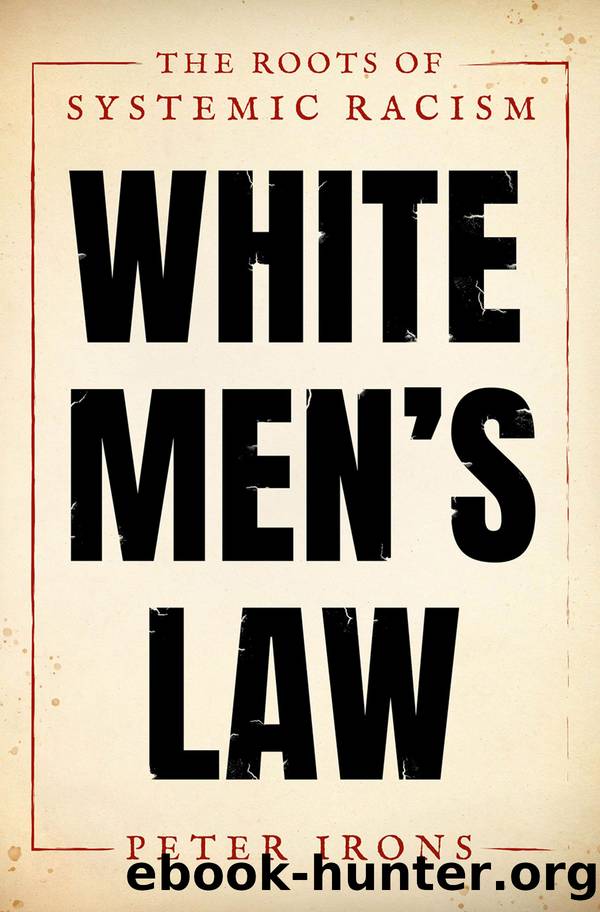White Men's Law by Peter Irons

Author:Peter Irons [Irons, Peter]
Language: eng
Format: epub
Published: 2021-01-15T00:00:00+00:00
8
âI Thanked God Right Then and Thereâ
this chapter will introduce readers to the Black parents and their children who first challenged Jim Crow schooling in the five cases that were unanimously decidedâfour in one opinion, the fifth in a separate opinionâby the Supreme Court in May 1954 under the caption Brown v. Board of Education of Topeka, Kansas. Everyone knows about the Brown case, and many recognize Linda Brown as the eight-year-old Black girl whose father, Oliver, sued on her behalf after Linda was turned away from the all-White Sumner grade school in Topeka, just six blocks from her home, and sent to the all-Black Monroe school, a half-hour bus ride away. But few people know that Oliver and Linda Brown were joined at the Supreme Court by Black parents and their children whose segregated schools were located in South Carolina, Virginia, Washington, D.C., and Delaware. We will take a journey from the Deep South to the Midwest heartland to help us understand how the institutions of education and law each responded to these legal challenges to almost a century of separate and unequal schooling for Black children. These two institutions wield enormous influence in determining how Americaâs children will be prepared for jobs in an ever-changing economy, and for their roles in civic affairs. Who brings these cases and who decides them at various times in the nationâs history reveals much about our societyâs commitment to the founding ideal of equality for all citizens.
We begin our journey in the small town of Summerton, South Carolina, ten miles south of Manning, the seat of Clarendon County, midway between Charleston and the state capital of Columbia. The 1950 census showed a county population of 32,215, with Summerton at 1,419 and Manning at 2,775. Eighty percent of county residents lived in rural areas, mostly on tenant farms, and 70 percent were Black. The average Black adult had just 4.2 years of schooling, and two-thirds of Black families had incomes of less than $1,000 a year. In short, Blacks in Clarendon County were poorly educated, earned barely enough to feed and clothe their families, and held no public office, despite their numerical majority. In 1950, the county school board spent $179 for each White student but only $43 for each Black child. In these respects, Clarendon was much like every Black-majority county in the Deep South.
What set Clarendon County and the town of Summerton apart from others like them was a visit to the Columbia office of Harold Boulware, the stateâs only Black civil rights lawyer, by Thurgood Marshall in March 1949. Boulware had been advising two Summerton parents, Levi Pearson and Rev. J. A. DeLaine, about a possible legal attack on the countyâs fourfold disparity in funding White and Black schools, and the all-White school boardâs refusal to provide school buses for Black children, many of them forced to walk miles over dirt roads to schools in converted sharecroppersâ cabins, while White kids passed them by in shiny yellow buses. Boulware was
Download
This site does not store any files on its server. We only index and link to content provided by other sites. Please contact the content providers to delete copyright contents if any and email us, we'll remove relevant links or contents immediately.
| Civil Rights | Discrimination |
| General | Human Rights |
Day by Elie Wiesel(2744)
The Age of Genius by A. C. Grayling(2555)
Gideon's Spies: The Secret History of the Mossad by Gordon Thomas(2318)
The Gulag Archipelago (Vintage Classics) by Aleksandr Solzhenitsyn(2063)
FATWA: Hunted in America by Pamela Geller(1982)
Columbine by Dave Cullen(1839)
Men Explain Things to Me by Rebecca Solnit(1705)
The Rule of Law by Bingham Tom(1667)
Anatomy of Injustice by Raymond Bonner(1636)
Examples & Explanations: Administrative Law by William F. Funk & Richard H. Seamon(1616)
Three Cups of Tea by Greg Mortenson(1595)
The Source by James A. Michener(1570)
That Every Man Be Armed by Stephen P. Halbrook(1556)
ADHD on Trial by Michael Gordon(1549)
Future Design by Unknown(1525)
Gideon's Spies by Gordon Thomas(1484)
Palestinian Walks by Raja Shehadeh(1479)
Constitutional Theory by Carl Schmitt(1427)
Nothing to Envy by Barbara Demick(1413)
